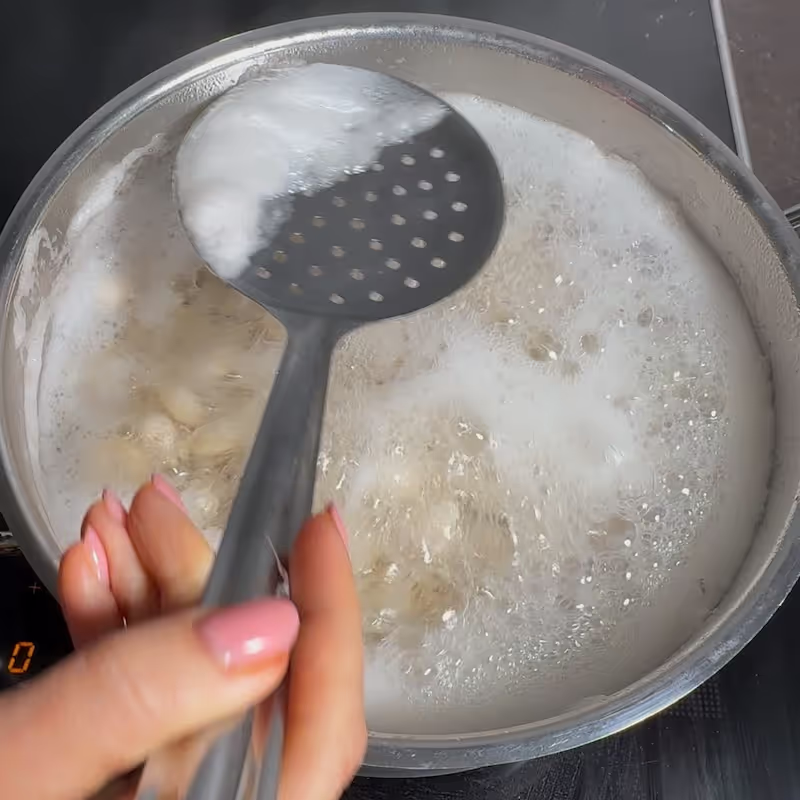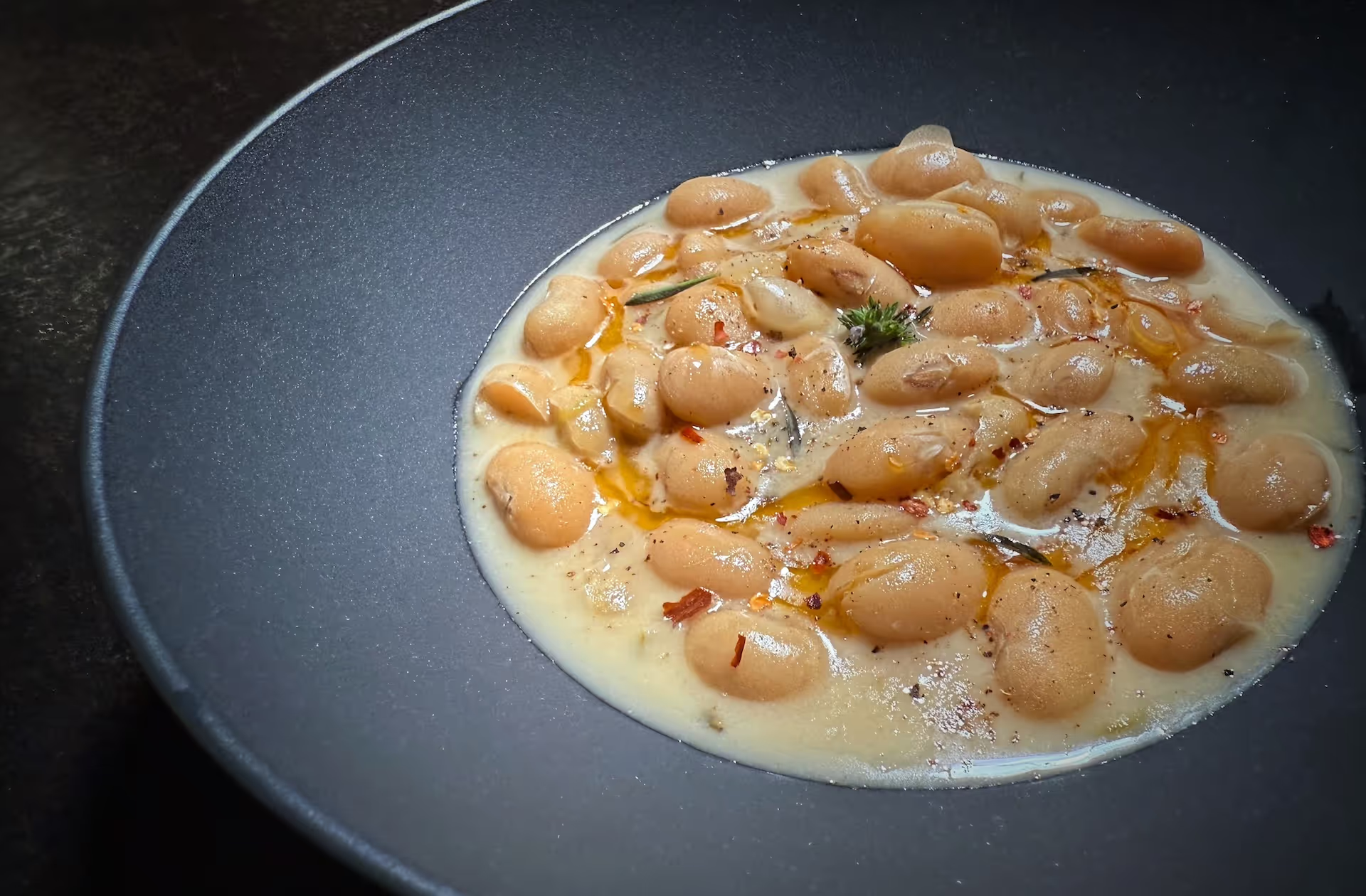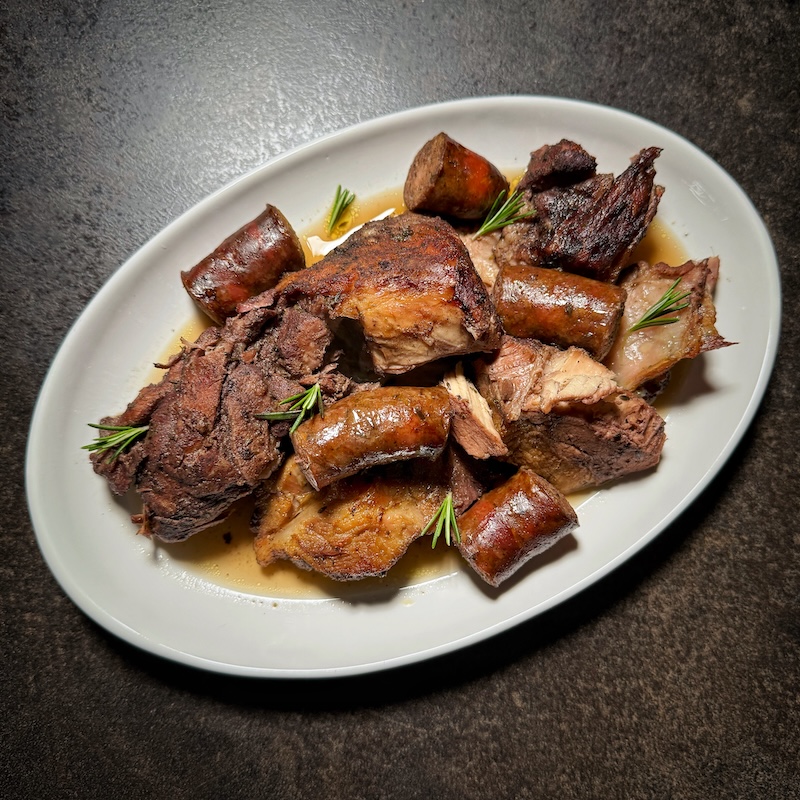Beans in a Creamy Wonderland
Rich and full of flavor creamy beans. Even though this is a cheap and easy to prepare dish, the explosion of taste makes it worthy of pretentious guests.
Servings
Prep Time
Cook Time
Ingredients
Total Time
Ingredients
- 400 grams of dried beans
- 100 ml double cream
- 1 piece of fresh thyme
- 1 piece of fresh sage or rosemary or other aromatic plant of your choice
- 5 tsp olive oil
- 4 cloves of garlic
- half of lemon
- 3 tsp salt
- 1 tsp black pepper
- 2-4 cups of water
- 1 tbsp of chili flakes for serving
Equipment
- Pot
- Skimmer Spoon
- Knife
- Wooden Spoon
- Ladle
Instructions
Growing up in Romania, beans were a constant at our table—humble, filling, and cooked in just a handful of beloved ways. Those classics still have my heart, and one day I’ll share them with you.
But this dish is what happened when I stepped outside that comfort zone and asked, “What if beans could be softer, silkier, brighter—yet still taste like home?” The answer is a pot of mixed beans gently simmered with lemon and aromatic herbs, finished with a whisper of cream that turns the broth into a velvety sauce.
This is slow, simple cooking: no browning or frills, just patience, fragrance, and texture.
It’s the kind of recipe that returns to your table again and again because it’s soothing, deeply flavorful, and surprisingly elegant.
Step-by-Step Instructions
- Soak: Add the beans to a pot and cover with plenty of cold water. Soak overnight.
- Don’t discard flavor: The next day, ensure the beans are well covered; top up with water if needed. Salt the water and bring to a boil.
- Skim: After ~30 minutes, foam will rise.
- Skim it patiently for 15–20 minutes as needed.

- Aromatics in: Reduce to a steady simmer. Add the peeled garlic cloves, olive oil, lemon, and your herb bundle.

- Slow cook: Simmer gently, partially covered, until the beans are soft and tender. Depending on the beans and soak, plan for 2 to 4 hours. Keep the liquid level just at the beans—add hot water if needed.
- Taste & remove: When the beans are silky-soft, fish out the lemon and herbs.
- Make it creamy: Lower the heat and pour in the cream.

- Bring back to a gentle bubble and cook 10 minutes to thicken slightly and marry the flavors.
- Finish & serve: Taste and adjust salt. Serve as is, or top with chili flakes. For a punchy twist, scatter over a little crisped spicy chorizo.
Serving Ideas & Variations
- Herb mood: Switch thyme/rosemary for dill or tarragon for a fragrant, springlike profile.
- Citrus switch: Try a strip of lemon zest if you prefer not to simmer the whole lemon halves.
- Heat level: Chili oil, Aleppo pepper, or smoked paprika give distinct personalities without overpowering the beans.
- Texture play: A handful of lightly crushed beans stirred in at the end thickens the sauce naturally.
Behind the Pot: How This Recipe Came to Be
I’ve always associated beans with the Romanian dishes of my childhood—comforting, straightforward, and honest. When I started exploring new ways to serve them, I wasn’t looking to replace tradition but to add a new page to it. The idea was simple: keep the soul of beans intact while elevating the broth into something you’d happily serve to guests. Lemon and herbs introduce brightness and perfume without stealing the show, while the olive oil softens edges and carries flavor. The final touch—cream—doesn’t make this heavy; it makes it luxurious. Think of it as slipping a silk lining into a favorite coat: familiar on the outside, unexpectedly smooth within. The mixed-bean approach was a happy accident. One evening, I had small amounts of different beans left in the pantry, and together they made the pot feel alive—creamy cannellini, sturdy white beans, and meaty kidney beans. That textural conversation is why this became a repeat dinner in our home.
Nutrition Notes: What’s Inside the Bowl
Beans are nutrient-dense and budget-friendly, a rare combination that makes them invaluable in everyday cooking. They are naturally rich in plant protein and dietary fiber, which helps with satiety and supports digestive health. Fiber also plays a role in balancing energy release—great for steady, longer-lasting fullness.
Beans provide notable minerals like iron, magnesium, and potassium, and B vitamins such as folate (important for cell function).
Soaking beans overnight, then cooking them low and slow, does more than improve texture—it can help many people enjoy beans more comfortably. Gentle simmering keeps skins intact and interiors creamy.
The recipe’s olive oil adds heart-friendly fats and helps carry the lemon-and-herb aromatics throughout the pot. The cream turns the cooking liquid into a sauce, which means you’ll naturally use less cream than you would in a standalone cream soup, yet you still get that plush mouthfeel. If you want a lighter finish, you can reduce the cream or swap part of it for milk or a splash of unsweetened plant cream.
For iron absorption, a touch of citrus is helpful—here the simmered lemon already gives you that. If you’re pairing these beans with greens or a tomato salad, you’re adding even more vitamin C to support absorption. Finally, seasoning matters: salt in the cooking water seasons the beans from the inside out, so you’ll likely need less finishing salt overall.
Bean Basics & Interesting Facts
Beans have been part of human diets for thousands of years, valued across cultures for their versatility and sustenance. While varieties like cannellini and kidney beans are common in European and American kitchens, countless heirloom types exist—each with distinct size, skin thickness, and flavor. Mixing varieties in one pot is more than aesthetic; it creates layered texture. Some beans break down slightly and enrich the broth, while others hold their shape and provide bite.
Aromatics change the story dramatically. Bay leaves add soft structure to the aroma; thyme and rosemary bring a woodland note; dill or tarragon tilt the dish toward Eastern European spring flavors. Lemon is the quiet hero: simmered whole or halved, it infuses the broth with fragrant oils while tempering the earthy edge of legumes.
Foam during boiling is normal—it’s a mix of proteins and starches. Skimming keeps the broth clear and the flavor clean. Maintaining a gentle simmer instead of a rolling boil protects the beans from splitting and keeps the liquid from evaporating too quickly. Think of bean-cooking as hospitality in pot form: simple ingredients, time, and attention turning into something generous enough to feed many with grace.
Conclusion
I hope you’ll cook these Beans in a Creamy Wonderland, enjoy every comforting spoonful, and tag us when you do—we love seeing your versions.
The full video of the recipe is available on YouTube, so check it out, and don’t forget to like and subscribe for more recipes and kitchen inspiration.
Nutrition Facts / Serving
- Calories 395
- Total Fat 38 g
- Cholesterol 80 mg
- Sodium 414 mg
- Potassium 72 mg
- Total Carbohydrate 25 g
- Sugars 1 g
- Protein 8 g




.svg)







